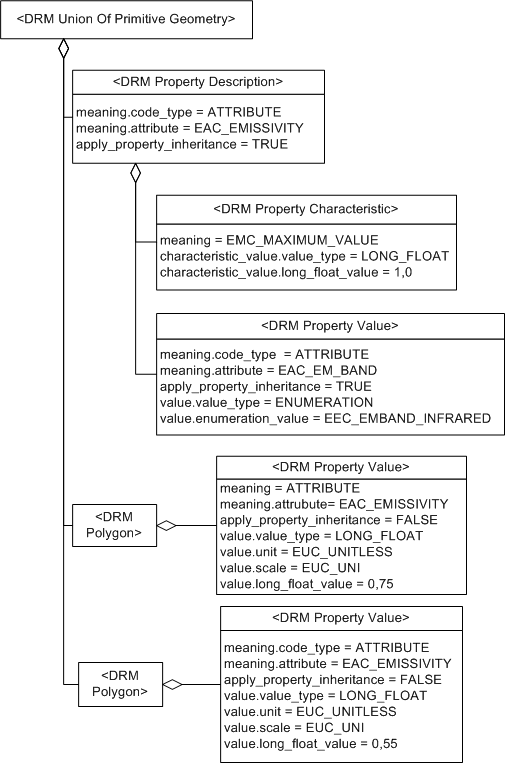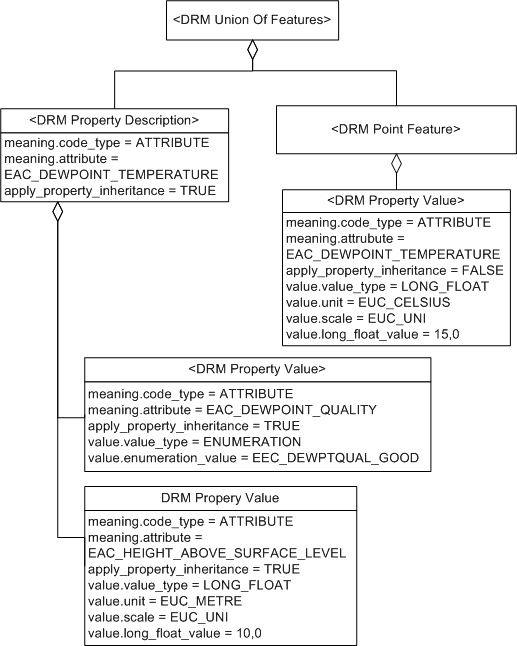Class Name: Property Description
Subclasses
This DRM class is concrete and has no subclasses.
Definition
An instance of this DRM class is used to elaborate a property of
an <Aggregate Geometry> instance or
<Aggregate Feature> instance and/or its
component inheritance subtree by specifying
<Property Characteristic> components
and/or qualifying <Property Value> components
that meaningfully limit the property identified by the
<Property Description> instance.
Primary Page in DRM Diagram:
Secondary Pages in DRM Diagram:
Example
Consider a <Union Of Primitive Geometry> instance
containing <Polygon> instances,
each of which has an emissivity applicable to the infrared band only,
where valid values are less than or equal to 1.0,
as depicted in Figure 41.

Figure 41 — <DRM Property Description> infrared emissivity example
The emissivity of each <Polygon> instance is
applicable to the infrared band only, because that property is so
qualified by inheritance.
Consider a <Union Of Features> instance containing various
<Primitive Feature> instances
that shall specify dewpoint temperature. For all the
<Primitive Feature> instances
in this aggregate, the dewpoint temperature given was taken at a height
of ten metres above the surface of the terrain, and is of good quality,
as depicted in Figure 42.

Figure 42 — <DRM Property Description> dewpoint temperature example
Since the <Point Feature> instance's
<Property Value> component describes
EAC_DEWPOINT_TEMPERATURE, it inherits
the following qualifiers:
-
The EAC_DEWPOINT_TEMPERATURE measurement was taken at
a height of ten metres above the surface.
-
The measurement is of good quality.
FAQs
-
How does an aggregate object use a <Property Description>
instance?
In two ways, either separately or in combination.
An aggregate may use a
<Property Description> instance to specify
<Property Characteristic> components
(such as maximum value for a quantity).
An aggregate might also use a
<Property Description> instance's
<Property Value> components to qualify an EAC.
All objects in the component inheritance tree of the aggregate, as long
as they have <Property Value> instances
with a matching EAC, are subject to the
<Property Description> instances
and/or qualifying values.
-
Can a data provider qualify an attribute A with two sets of qualifying
<Property Value> instances, {b1, c1} and
{b2, c2} by associating two <Property Value>
instances for A with the corresponding qualifier set?
No. This situation requires a <Property Table> instance.
-
Are there any restrictions on the
<Property Value> components?
Only semantic restrictions. For example, it makes sense to limit
the applicability of an electromagnetic emissivity value to a
particular electromagnetic band. But it would be nonsensical
to limit an electromagnetic band to a particular emissivity value.
Constraints
Composed of (two-way) (inherited)
Composed of (two-way)
Component of (two-way)
Notes
Fields Notes
The meaning field
specifies the meaning of the
<Property> instance.
If apply_property_inheritance
is SE_TRUE for the <Property> instance
P, P shall be inherited;
otherwise, P shall not be inherited.
Prev: Property Characteristic.
Next: Property Grid.
Up:Index.

